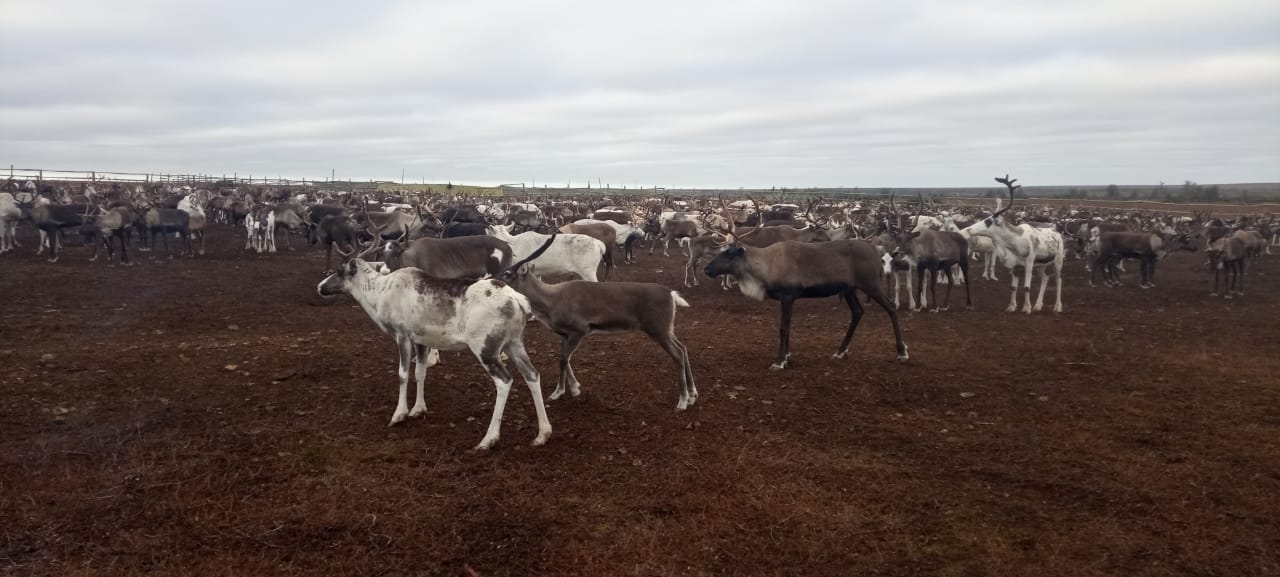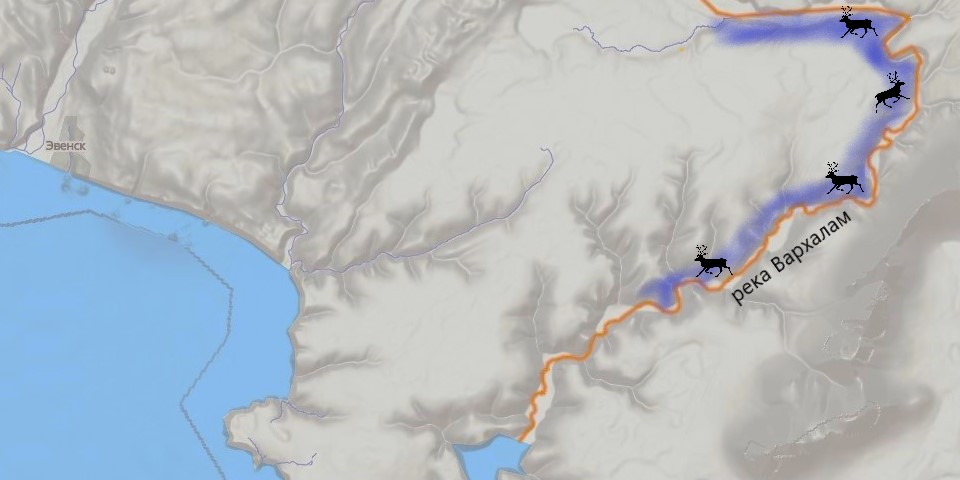ИЗУЧЕНИЕ ВОЗБУДИТЕЛЕЙ ОВОДОВОЙ ИНВАЗИИ И ЕЁ ПРОФИЛАКТИКА У ОЛЕНЕЙ ЭВЕНСКОЙ ПОРОДЫ КРАЙНЕГО СЕВЕРА ДАЛЬНЕГО ВОСТОКА
ИЗУЧЕНИЕ ВОЗБУДИТЕЛЕЙ ОВОДОВОЙ ИНВАЗИИ И ЕЁ ПРОФИЛАКТИКА У ОЛЕНЕЙ ЭВЕНСКОЙ ПОРОДЫ КРАЙНЕГО СЕВЕРА ДАЛЬНЕГО ВОСТОКА
Аннотация
Оводовая инвазия является актуальной проблемой для домашнего северного оленеводства Магаданской области. Снижение ущерба, причиняемого оводовыми инвазиями, повышение продуктивности оленеводства определили актуальность данной работы. Научно-исследовательская работа проводилась в 2022 году во время экспедиций в оленеводческое хозяйство КФХ ИП «Коркопский». Цель работы – подбор эффективного средства против эдемагеноза и цефеномийоза северных оленей. Изучен видовой состав, сезонная динамика, суточный ритм активности нападения оводов на северных оленей. Определён видовой состав оводов: носоглоточный – Cephenomyia trompe и подкожный – Oedemagena tarandi. Первые подкожные и носоглоточные оводы появлялись в начале третьей декады июня при температуре воздуха 11-13°С и скорости ветра 1,7-1,8 м/сек, относительной влажности воздуха 53-56%. Лёт оводов продолжался 28 дней, а массовый – приходился на первые числа августа. Дегельминтизация проводилась на 1-ой стадии оводовой инвазии с применением ивермека. На основе исследований разработаны методы борьбы с оводовой инвазией в оленеводческих хозяйствах Магаданской области.
1. Introduction
For several years Magadan Scientific Research Institute of Agriculture – branch of the Federal State Budgetary Institution of the N. I. Vavilov All-Russian Institute of Plant Genetic Resources conducts research in the field of deer diseases associated with gadfly infestation, which have always been of great relevance among diseases of various etiologies.
Domestic reindeer husbandry is directly dependent on the influence of external environmental factors and, in particular, parasitic nature. On pastures during the summer feeding period of reindeer, gadflies create unbearable conditions for their rest. Deer, fleeing for their lives, spend most of the time intended for grazing protecting themselves from insects. All this leads to a weakening of the body's defenses. Gadfly larvae, parasitizing the deer's body in winter, exhaust them, especially calves, which often die.
For the development of northern reindeer husbandry, it is necessary to prevent the damage caused by the subcutaneous gadfly, the especially strong effect of which is manifested in the autumn-winter-spring period, that is, in the larval phase of development , , .
Increasing the productivity and profitability of reindeer husbandry is impossible without a reliable organization of effective protection of reindeer from gadfly infestation. Currently, domestic manufacturers do not produce enough drugs to combat gadflies and gadfly infestations. The well-proven drugs have been discontinued, replaced by new protective equipment that require experimental testing in the Far North , , , .
Scientists of the Magadan Scientific Research Institute of Agriculture (Magadan) in the Soviet period carried out research on the gadfly invasion of reindeer: studied the species composition, seasonal dynamics and daily rhythm of the activity of gadfly attacks on animals; ensured the organization and control of summer anti-water treatments in reindeer herds of state farms; conducted scientific and production experiments and testing new drugs to protect deer from gadflies.
Currently, the Ministry of Agriculture of the region, in collaboration with the Magadan Research Institute of Agriculture, is developing joint work plans to restore the lost gene pool of the Even breed of reindeer.
There is an urgent need to resume scientific research in reindeer herding farms of the Magadan region in the direction of diagnosing particularly significant diseases of domestic deer in conjunction with the study of the allelofund of the Even breed.
Minimizing the damage caused by gadfly infestations and increasing the productivity and profitability of northern domestic reindeer husbandry determined the relevance of this work. The purpose of the work is to select an effective remedy against edemagenosis and cephenomyosis of reindeer in the conditions of reindeer herding farms in the Magadan region. The objectives were expressed in the study of species composition, seasonal dynamics, and the daily rhythm of the activity of gadfly attacks on reindeer.
2. Material and research methods
The research was carried out in 2022 during expeditions in the field at the reindeer herding farm of the Korkopsky private farm, located in the North-Evensky district of the Magadan region and in the laboratories of the institute. The object of the research was reindeer of the Even breed in the amount of 1322 individuals and causative agents of gadfly infestations: Cephenomyia trompe и Oedemagena tarandi.
Records of flying forms of subcutaneous gadflies on the control deer were carried out, while meteorological factors were recorded. According to the daily records, the seasonal dynamics of gadfly attacks on deer were established. The number of flight days and population peaks during the day and season were revealed, which made it possible to carry out treatments during their greatest activity to protect deer.
To establish the timing of larval fallout for pupation in the field, the fallen larvae were collected, taking into account the time of their fallout, as well as the temperature and relative humidity of the air, wind speed, illumination and soil surface temperature. The degree of invasion by C. trompe and O. tarandi larvae was determined during the slaughter of deer and their death, by examining the skins for the detection of subcutaneous gadfly. The study of the development of larvae of the 2nd stage of nasopharyngeal gadfly was carried out by systematic dissection of deer heads, while the lesion of deer and the location of larvae were recorded.
The means of carrying out autumn treatments were antiparasitic drugs, syringes, portable and stationary corrals. The daily rhythm of activity and seasonal dynamics of flight of adult gadflies was carried out in accordance with the method of K.A. Breeva .
3. Main results

Figure 1 - Even breed deer on pastures in the tundra zone of the North Evensky district of the Magadan region

Figure 2 - The route of the herd of Even breed deer in the tundra zone of the North-Evensky district of the Magadan region
It was established that the first subcutaneous and nasopharyngeal gadflies appeared in the forest-tundra at the beginning of the third decade of June at an air temperature of 11-13 ° C and a wind speed of 1.7-1.8 m/sec, and a relative air humidity of 53-56%. The end of the flight of subcutaneous gadflies occurred in the middle of the third ten days of August, after cool, cloudy weather sets in. The number of days of mass flight of subcutaneous gadflies is from 45 to 46, and the total flight duration is 68 days (Table 1).
The daily rhythm of activity of gadflies depended on calendar dates. In July, the flight began at 6-7 a.m. at an air temperature of 11-12 ° C, and ended at 8-9 p.m.; in August from 8-9 a.m. at an air temperature of 08-10 ° C, illumination of more than 10 thousand lux and ended at 7-8 p.m. At the end of August – beginning of September, the number of gadflies was insignificant, but the aggressiveness of their attack was the greatest. The largest number of gadflies attacking reindeer was 34 in 30 minutes.
Table 1 - Timing of flight of adult subcutaneous and nasopharyngeal gadflies in the forest-tundra of the North-Evensky district of the Magadan region
Natural area | Flight start date | Flight end date | Total flight duration, days. | Number of days of mass flight |
Subcutaneous gadfly | ||||
Forest-tundra | 20–22.06. | 21–27.08 | 68 | 45-46 |
Nasopharyngeal gadfly | ||||
Forest-tundra | 25.06. | 18.08 | 59 | 30 |
The subcutaneous gadfly in the tundra usually appears in the 3rd decade of July, and the nasopharyngeal gadfly – in mid-July, at an average daily air temperature of + 18-20⸰C and a relative air humidity of 60-65%. The flight of gadflies lasted 24-28 days, and the mass flight occurred in the first days of August (Table 2).
In clear sunny weather, the flight of subcutaneous gadflies began at 10 a.m. The highest flight activity was observed at 3 p.m., after which it began to decline and by 7 p.m. it stopped altogether. Wind speeds not exceeding 5 m/s did not affect the flight of gadflies. The average wind speed was insignificant and amounted to 0.9 m/s. Days of increased flight activity of gadflies were marked by high temperatures, good solar illumination and low wind speeds.
The incidence of nasopharyngeal gadflies is significantly lower than subcutaneous ones. Their first appearance was observed in the first half of July at an average air temperature of + 17-20⸰С and a relative air humidity of 60-65%.
Table 2 - Timing of flight of adult subcutaneous and nasopharyngeal gadflies in the tundra of the North-Evensky district of the Magadan region
Natural area | Flight start date | Flight end date | Total flight duration, days. | Number of days of mass flight |
Subcutaneous gadfly | ||||
Tundra | 22.07. | 15.08 | 28 | 13 |
Nasopharyngeal gadfly | ||||
Tundra | 15.07. | 15.08 | 24 | 11 |
From mid-August to the first ten days of September, the flight of gadflies practically stops, and deer switch to a quiet grazing regime. At this time, it is most effective to carry out early chemotherapy followed by the destruction of stage 1 larvae in the body of reindeer, using the antiparasitic drug ivermec, which has a systemic effect of the class of macrocyclic lactones , .
Before using the drug, the required dosage was set for different sex and age groups of animals: 200 mcg per 1 kg of animal weight. A single intramuscular injection of the drug into the croup area was carried out using a dosing syringe model: “Henke Vet-Matic Luer-Lock dosing syringe”.
Based on data from post-mortem veterinary and sanitary inspection of deer carcasses and skins, carried out in the first half of this year, the extent of infestation of females by the larvae of the subcutaneous gadfly was 5.0%, calves – 7.0%, bulls (up to 1 year) – 4.0%, bulls – 3.0%.
4. Conclusion
1. For the first time, the species composition of gadflies has been determined: nasopharyngeal – Cephenomyia trompe and subcutaneous – Oedemagena tarandi in Even breed deer in the North Evensky district of the Magadan region;
2. For the first time, seasonal dynamics and the daily rhythm of the activity of gadfly attacks on reindeer in the North-Evensky district of the Magadan region have been studied;
3. Low rates of infection of deer by subcutaneous botfly larvae have proven the effectiveness of the use of the antiparasitic drug ivermek against edemagenosis and cephenomyosis of reindeer in the conditions of reindeer herding farms in the Magadan region.
